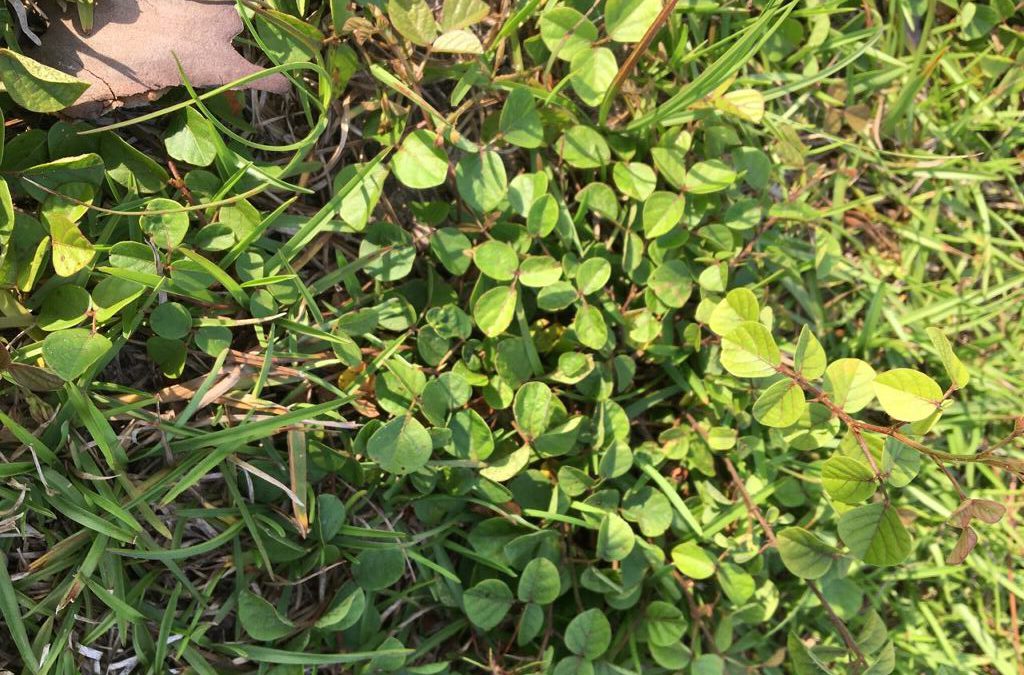
by Ashley Stonecipher | Jun 21, 2022
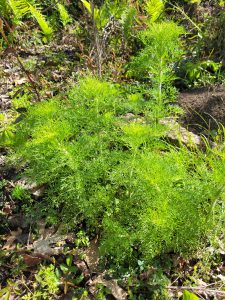 Summer weeds are here. What should we do? As we are officially into summer you are probably noticing many of those summer weeds poking through your lawn by now, or perhaps they have taken over completely. Do not give up, there is still hope for a beautiful lawn with less weeds.
Summer weeds are here. What should we do? As we are officially into summer you are probably noticing many of those summer weeds poking through your lawn by now, or perhaps they have taken over completely. Do not give up, there is still hope for a beautiful lawn with less weeds.
The first thing is to be able to identify the weed and identify the type of grass. Now you may be thinking that is impossible and maybe you are thinking why it is important to identify those? The answer to that question is simply that not all chemicals are the same and understanding what you have and the best time of year to spray for that will save you both time and money. Weeds fall into three categories: Broadleaf, Grass, and Sedge. Remember, a weed could be any plant that is out of place. Weeds will compete with desirable plants for nutrients, water, light, and space.
Once you understand what category your weed falls into the next step is to know the life cycle. For example, winter annuals will die out naturally as the temperatures increase and a chemical may not be needed. There are weeds that complete their cycle in one year (winter and summer weeds) and there are weeds that complete their cycle in two years (biennials). A biennial has vegetative growth the first year and will flower and die the second year, examples are Carolina false dandelion, Oldfield toadflax, and cudweed.
Next you will want to identify the indicator species. What does this mean? It means that there are some weeds that grow well in compacted soils like goosegrass and annual bluegrass. Others like it very wet (poor drainage) such as dollar weed, sedges and torpedo grass. While there are weeds such as sandbur and rustweed that like it very dry and sandy. Knowing this can help you do preventative weed control. Grow a healthy turf starting with the right selection, proper cultural practices, pest control, traffic control, and sanitation.
When you are faced with the decision to use chemicals to combat your lawn weeds there are a few things to know. There are selective herbicides that control certain species without hurting others (your lawn) and there are nonselective herbicides that control green plants regardless of species. Also, there are contact herbicides, which are exactly how their name implies. They affect only the portion of the plant that the herbicide touches. There are also systemic herbicides which are translocated through plant’s vascular system.
The best time to spray herbicides is when the weeds are actively growing, young and not drought stressed or producing seed heads. A table below shows the active ingredients best for the three categories of weeds.
|
Broadleaf Weeds |
Grassy Weeds |
Sedge Weeds |
| Centipede |
2-4D + Dicamba +MCPP Thiencarbazone+iodosulfuron + dicamba |
Sethoxydim |
Halosulfuron-methy, Sulfentrazone, Imazaquin, Bentazon, |
| Bermuda |
2-4D + Dicamba +MCPP Thiencarbazone+iodosulfuron + dicamba |
Quinclorac |
Halosulfuron-methy, Sulfentrazone, Imazaquin, Bentazon, |
| Zoysia |
2-4D + Dicamba +MCPP Thiencarbazone+iodosulfuron + dicamba |
Fluazifop, Quinclorac |
Halosulfuron-methy, Sulfentrazone, Imazaquin, Bentazon, |
| St. Augustine |
2-4D + Dicamba +MCPP Thiencarbazone+iodosulfuron + dicamba |
None |
Halosulfuron-methy, Sulfentrazone, Imazaquin, Bentazon, |
|
**temperature restrictions |
|
|
The key is to identify the type of turf you have and the type of weeds you have in the lawn. Further, look into if there are any factors that can be adjusted that might be causing the excess of weeds. And lastly, make sure you are using the right method, chemical, and timing for control. For more information on summer weeds and lawns, please contact your local county extension office.
Information for this article can be found Managing Weeds in Warm Season Lawns | Home & Garden Information Center (clemson.edu)

by Ashley Stonecipher | May 26, 2022
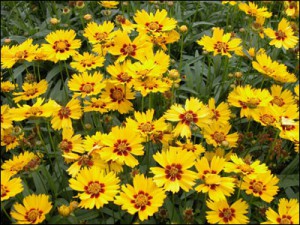
Coreopsis flowers. Photo courtesy UF/IFAS.
A beautiful wildflower that lines the roads and open areas is one of my favorite native pollinating plants. Coreopsis also commonly known as Tickseed was designated our Florida State Wildflower in 1991. It can be found throughout Florida and all 17 species occur in North Florida. Varieties such as Leavenworth’s Swamp (C.nudata), Florida (C. floridana) and Coastalplain (C. gladiata) are found in moist areas and other varieties like Lanceleaf Tickseed (C. lanceolata) and Goldenmane Tickseed (C. basalis) are commonly found in the drier areas of the landscape.
All the varieties of Tickseeds have daisy-like flowers with yellow petals except for the Swamp Tickseed which is more pinkish purple in color. The flower gets its common name by the appearance of the small ovalish seed that has two short spines at one end and looks like a ‘tick’. The most common coreopsis is Coreopsis leavenworthii. This plant can be found in moist pinelands and disturbed sites. You can spot the blooms of bright yellow ray petals with brownish central disk flowers from late spring through late fall. This coreopsis can reach 3 feet in height. It grows like a weed and can quickly establish itself on bare soil. Coreopsis is essentially an annual with our colder winters but produces many seeds that will multiply as long as the plant receives adequate sun and moisture. A special species of coreopsis found only here in the Panhandle is the Chipola coreopsis (C. integrifolia). It is less common and only found along the Chipola River. This 18-24” plant has deep green oval-shaped leaves and deep yellow flowers seen blooming in the Fall, maybe a great time to go kayaking or hiking along the river! The Chipola coreopsis prefers moist soils and some protection from the sun. This variety is so rare that it has been listed endangered by the Florida Department of Agriculture.
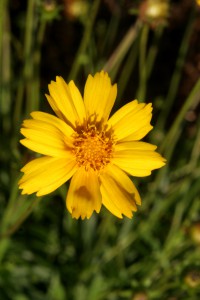
Native Lanceleaf Coreopsis. UF/IFAS Photo: Thomas Wright.
Coreopsis is pollinated mostly by small bees and not visited as much by butterflies and other pollinators. They are a great plant to use for a show of color! You can get seeds from your local garden center or from the Florida Wildflower Growers Cooperative (https://floridawildflowers.com). This Florida-Friendly plant is drought tolerant and can be sown anytime from October to January.
Sources:
https://www.flawildflowers.org/wp-content/resources/pdfs/Publications/AboutCoreopsis.pdf
https://gardeningsolutions.ifas.ufl.edu/plants/ornamentals/coreopsis.html
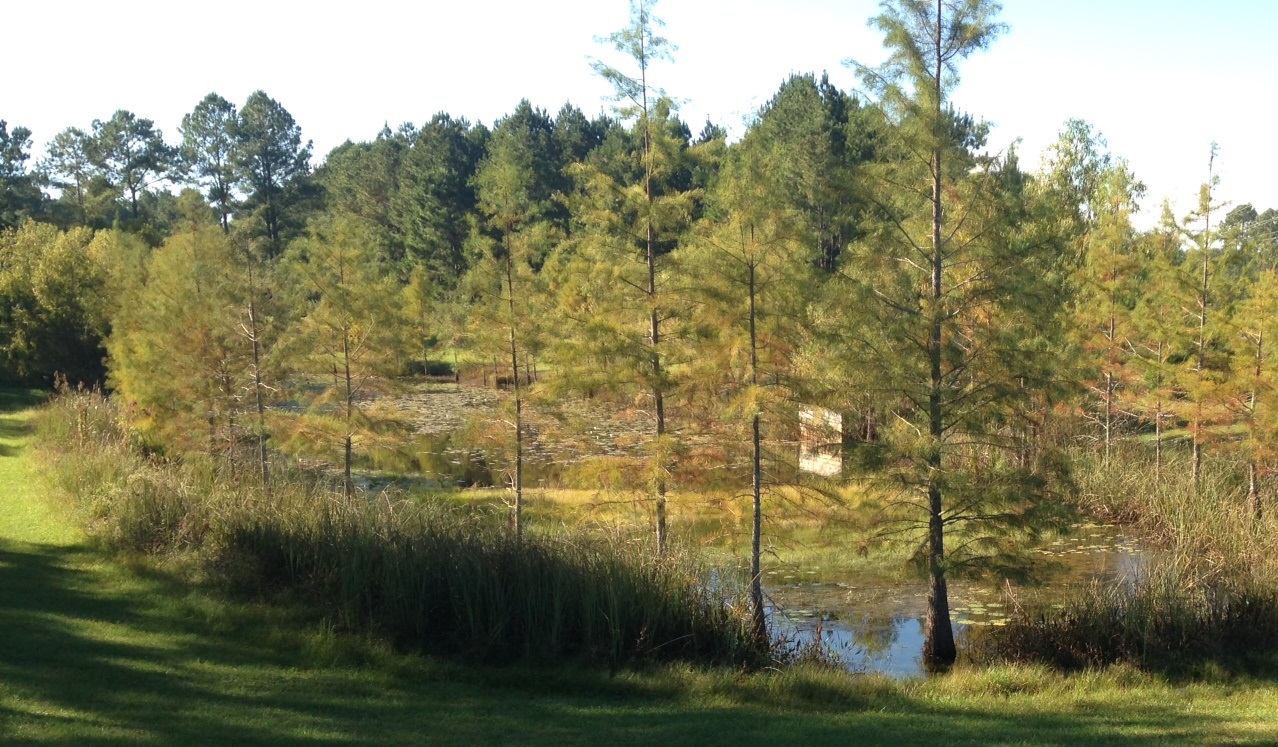
by Ashley Stonecipher | Apr 20, 2022
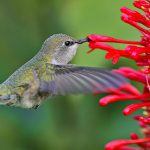
A hummingbird gathering nectar from a firespike (Odontonema strictum) flower. Photo Credit: Knolllandscapindesign.com
Do you enjoy watching a variety of birds and butterflies in your landscape? Have you ever watched squirrels get into the birdfeeder? Children may learn about wildlife by watching through a window. Food, water, cover, and space are four essential elements that will create the best habitat for wildlife. Food could be as simple as adding feeders to attract birds to your yard but having a habitat that sustains them is important. Florida wildlife and Florida native plants evolved together and are often interdependent. It is a must to understand what sustains the species you are wanting to attract to your area. Different species prefer different food/plants. Insects also provide birds a food source for their young.
Water can be bird baths, man-made ponds, and natural bodies of water such as streams, lakes, ponds on your property. When relying on a bird bath for your water supply make sure the water is fresh and clean. Shallow water (1-1.5 inches) is better than deep (over 3 inches). Birds like sloping sides and a textured surface; they prefer to walk into water rather than dive in headfirst. Place the bath 5 to 10 feet from a protective cover like shrubs or trees. This needs to be close enough for the birds to be able to reach safety if there is danger from predators. A small outpost for birds to land on near the bath can help them check for predators before heading to the bath.
Cover will provide a place to raise young and should have vertical layers for animals to use for safety, shelter, and nests. Examples of cover that could be added to the landscape are snags that give food for woodpeckers and nesting perches. Or build your own nesting boxes that are species specific for owls, bees, and bats. All bats eat insects and substantially reduce the number of nocturnal insects in a neighborhood.
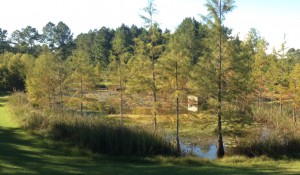
The permanently wet detention pond lined with cypress trees and sawgrass also provides habitat for fish, birds, and reptiles. Photo Credit: Carrie Stevenson, University of Florida/IFAS Extension – Escambia County
Lastly it is important to think of your space. Create large patches of good habitat that span several landscapes or consider working with your neighbors to link the backyard habitats and create a larger area. It is all about the “Right Plant, Right Place” concept and understanding the area you are working with and the possibilities. When you go into the last step of planting and attracting wildlife have a plan and know what you would like to attract. Do your research on what you will need for that wildlife and use your resources, ask your local extension agent for ideas and suggestions!
Many plants in our native landscape provide much of what attracts wildlife and provides them with at least one of the four essential elements. The article “Planting for Wildlife Habitat!” will give you some ideas of plants and trees that do well in the North Florida area and will help to attract the wildlife you desire!
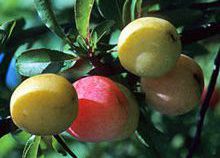
by Ashley Stonecipher | Apr 14, 2022
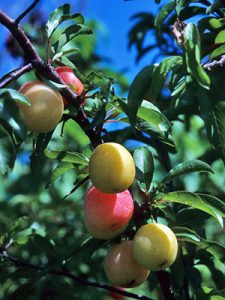
Humans and wildlife find Chickasaw plums delicious. Photo credit: University of Florida/IFAS
There are many trees that can be a great addition to your space that will provide one of the four essential elements food, water, cover, and space. Persimmon thrives in a wide variety of conditions from wet or sandy soil to lowlands or uplands. Deer actively seek out persimmon trees, eating every fruit that is within reach as well as leaves and twigs in the fall and winter. Other wildlife that enjoys the persimmon trees are squirrel, fox, bear, coyote, raccoon, opossum, and various birds including wild turkey. The nectar from flowers provides a significant food resource for pollinator species like bees. These trees are either male or female and at least 3 should be planted together to ensure pollination. Live Oak is a solid tree that many people in this area said survived Hurricane Michael. It provides acorns for food and deep shade. Black Cherry is a host plant for Red-Spotted purple and Eastern Tiger Swallowtail. Bitter fruit matures during the summer to fall and is used for jams, jellies, or liqueurs. Fruits are highly prized by birds and other wildlife. Wild cherry cough syrup is made from the reddish-brown, fragrant and bitter inner bark. Yaupon Holly is another tree that birds and wildlife feed on the berries throughout the winter when food is scarce. Leaves have the highest caffeine content of any other plant native to North America. Some other trees to consider are Basswood, Red Cedar, Florida Hop tree, Elderberry, Slippery Elm, Sassafras, Chickasaw Plums, and the Toothache Tree.
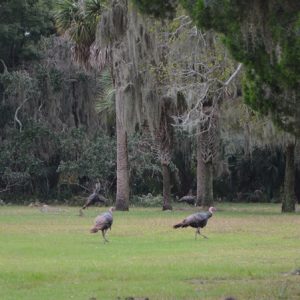
While yard work is important to maintain an attractive lawn, if done successfully, the resident can spend quality time in other pursuits like watching the wildlife from the front porch.
There are many plants that for the longest time I thought were only a nuisance to the everyday gardener, but I truly learned the phrase “Right Plant, Right Place” with these next few plants that I am going to mention. Smilax is a vine with thorns that is nearly impossible to get rid of and gets into our shrubs and landscape. But in the right place smilax provides shelter and food for wildlife. It has a blue-black berry in the spring and provides medicine, food, and dyes for humans. There are 2 species of smilax that are only found in the panhandle. Dog Fennel is native to fields, woodland edges, and roadsides and can be used as an insecticide and antifungal. It has feather like leaves that are very aromatic. Blackberry can grow wild and it is an all-around amazing plant for vitamins. It’s fruit can help fight cancer and decrease cardiovascular disease. Leaves and bark are useful medicinally and leaves can be used as a tea. The last plant I must mention is the Beauty Berry. It is known for its late fall bright purple fruits called drupes, not berries. This plant attracts birds for food in the fall time in North Florida. The drupes can also be used for jams and jellies. Other plants that are great for attracting wildlife are Spiderwort, Dewberry, and Spanish Needle.
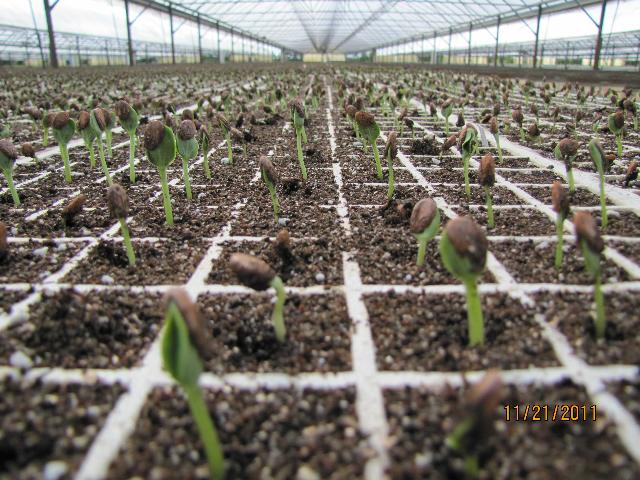
by Ashley Stonecipher | Mar 10, 2022
Some of the many benefits of starting your own home garden are having fresher, more nutritious produce, the positive effects on physical and mental health, increased consumption of fresh fruits and vegetables and a potential cost savings. Also there are many advantages to starting a garden in the spring with transplants. You avoid bad weather, achieve earlier and higher yields, avoid insect and disease issues, and can choose the best and strongest plants to add to your garden.
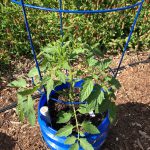
Using a self-watering container is an excellent option if you find yourself away from the garden this summer. Photo by Molly Jameson.
Now is the time to start planting seeds indoors for warm season crops such as tomato, pepper, cucumber, eggplant, okra, summer squash, watermelon and many more. It is important to consider the number of days to harvest, planting zone, and location to plant. Buy seeds from a reputable source and check the expiration dates/sell-by dates and follow the packet.
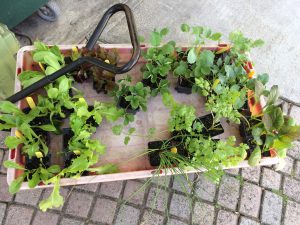
For some vegetables, buy transplants from your local nursery. Photo by Molly Jameson.
When seeding the containers follow instructions for the seeding rates, spacing and depth on your seed packet. Smaller seeds can be broadcast over the surface and larger seeds will need to be covered with soil. Temperature and humidity are important for germination. Your packet will be specific on how deep to plant the seeds and a range of how long it will take to germinate. Label your container with the vegetable name and date seeded. You may find yourself like me and thinking you will remember what it is only to be guessing what you have as it germinates!
Most seeds started indoors will be ready for the garden in 4 to 6 weeks. Transplants must be hardened off first which means you should reduce the amount of water and stop fertilizing 1-2 weeks before they are ready to go into the garden. The seedlings will need a good bit of sun/light and moisture once they germinate to avoid leggy and stretchy plants.
The next step is to care for your transplants. As you have taken the time to seed them, watch them grow, and then put the plants into their new home it is important to set them up for success. Monitor the transplants for insect and disease on a weekly basis. Make sure the garden is free of weeds before the plants go into the ground. Weeds will fight for the same water and nutrients as the transplants. Transplant when the environmental conditions are best. This means to plant them in the morning, on a cloudy/overcast day, and when there is not a big storm in the forecast. When taking the little transplant out of the pot be careful to not disturb the roots and do not pack the soil around the roots.
If you have any questions on spring gardening please contact your local extension office for more information.

 Summer weeds are here. What should we do? As we are officially into summer you are probably noticing many of those summer weeds poking through your lawn by now, or perhaps they have taken over completely. Do not give up, there is still hope for a beautiful lawn with less weeds.
Summer weeds are here. What should we do? As we are officially into summer you are probably noticing many of those summer weeds poking through your lawn by now, or perhaps they have taken over completely. Do not give up, there is still hope for a beautiful lawn with less weeds.











